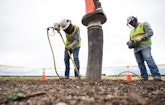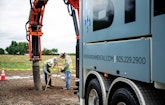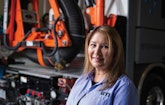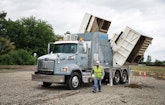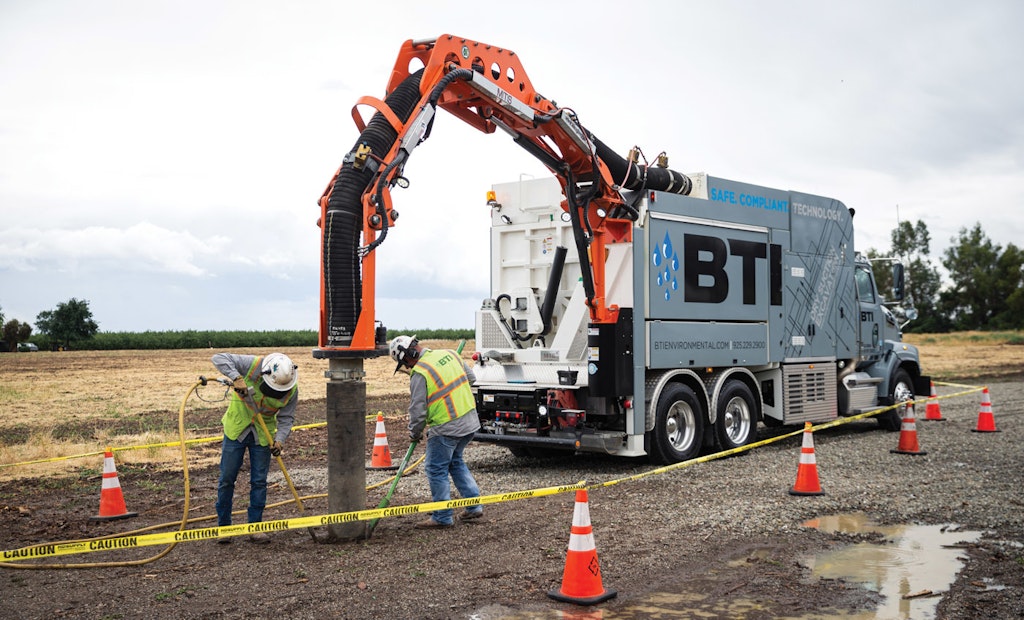
Technician Dustin Steele (left) uses the air lance, while operator Shawn Addison operates the mechanical boom of a Dino suction excavator (built by MTS GmbH and distributed by Ox Equipment) during an excavation job. (Photos by Collin Chappelle)
A couple of years ago, a customer asked Sharon Bonner if there was a way to reduce the high costs associated with transporting and disposing of mud spoil generated by hydroexcavating. As the owner of Bradley Tanks Inc. (BTI), a waste-hauling and frac-tank-rental company, Bonner did some research and found a solution: air-excavation technology that produces dry spoil that can be reused on site.
Bonner was immediately intrigued by the technology. But there was a sticking point: No other company in the U.S. had purchased the equipment, known as the Dino Series of suction-excavation trucks, built by MTS GmbH, a German manufacturer. Bonner had to make a significant decision to either serve as a technological guinea pig and persuade customers to embrace the technology — already popular in Europe — or avoid the risk entirely and stick with the status quo.
So in a pivotal “if you invest in it, they will come” moment in 2017, BTI bought a Dino suction excavator through Ox Equipment. (Ontario-based Ox Equipment is the North American distributor for MTS GmbH.) The stakes were high: At about $900,000 per unit, the Dino trucks represented a serious capital expenditure.
But the gamble has paid off. Today, BTI — based in Danville, California — is much more than just a company that rents frac tanks and provides nonhazardous and hazardous-waste hauling and disposal services; it became a forerunner in a new excavation frontier. The bottom line: What looked like a big calculated risk three years ago now appears to be a solid and sound business decision.
“It was a risky move,” says Bonner, who founded the company in 1999. “But I always look to the future. You can’t just say, ‘This is what we’re doing now and it’s working, so we’ll just keep doing it.’ Things change, and you have to be ready to adapt to those changes.
“We bought a Dino without even a contract in hand,” she recalls. “And so far, so good.” The company has added several more Dinos since then.
“That’s something Sharon always does — looks ahead to broaden the scope of what BTI can do,” says Kelly Graser, the company’s director of compliance. “It’s not the first time she’s had us develop and finance equipment that doesn’t even exist in the marketplace, just to provide specific solutions for our clients.
“This was just another time when she felt it was the right direction — the right time to step into this industry because it offered something completely different,” Graser continues. “We’re certainly not here to take over the hydroexcavating world. Hydroexcavating still has its applications. It’s just that this technology offers a number of benefits that have a place in project work.”
GO BIG OR GO HOME
BTI’s decision to invest in suction-excavation technology underscores both the importance of listening to customers and helping them find solutions to business challenges and of taking calculated risks to invest in game-changing technology.
In BTI’s case, the customer that spurred the investment was a utility company for which BTI handled wet-spoils disposal. While the air-excavation technology intrigued BTI’s management team, it also presented a bit of a conundrum because it also would reduce revenue generated by contracts for hauling and disposal of wet spoils.
Bonner felt the lost revenue could be offset by providing the air-excavation service, which also has applications in other industries. “We saw a demonstration of a Dino and thought this could work,” she says. “If we’re the ones that present the technology to customers, that’s a way to increase our revenue and make up for loss of revenue from wet-spoils contracts. It’s a risk you take.
“In the long run, we think this technology is the future because it’s more environmentally sustainable,” she adds.
AIR-TECHNOLOGY ADVANTAGES
Bonner saw an advantage to being the first to embrace this new technology in the U.S. For starters, the sheer high cost of the equipment presents a formidable barrier to market entry by others. In addition, customers were excited about the potential for reducing hauling and disposal costs.
“We knew how much customers were spending on disposal of wet spoil. The Dinos will help clients reduce the volume of mud,” Graser says. “For projects we now work on, about 95% of the spoil remains on site and gets immediately reused.”
The immediate reuse of spoil is another big selling point because it removes the cost of buying and transporting materials to job sites to backfill excavated areas. And the Dinos improve productivity because they don’t have to leave job sites to refill water tanks as hydroexcavators must, Graser says.
“And the excavated area is dry,” she continues. “So if people need to get back in there, they’re working in a dry environment instead of a wet, muddy environment. Another advantage is that the Dinos don’t use water to dig, so that conserves a natural resource. It also enables the trucks to work in remote areas where water isn’t always readily available and would be expensive to transport to job sites.
“Also, because the Dinos use air, it’s a soft-dig method, not mechanical,” she adds. “That’s significant because there are regulations about how close you can work to utilities with mechanical methods.”
BTI management envisions using the Dinos in other industries for various applications. “We felt it was the right fit not only for what our client needed, but also for anyone doing utility and other similar work,” Graser notes.
USE IN EUROPE
While suction-excavation technology has been used in Europe for decades, it’s relatively unknown in North America. BTI is busy changing that dynamic with its investments in the Dino trucks, which use pneumatic tools powered by compressed air to break up soil.
The units then suction up the loosened soil with a pair of high-powered fans. Unlike hydroexcavated soil, which turns into a slurry that’s costly to haul and dispose, the spoil generated by a Dino is dry and can be immediately reused on site for backfilling. That provides big cost-savings for customers, says Colin Donoahue, business development director for Ox Equipment.
The trucks are built on Western Star chassis and feature various sizes of steel debris boxes, available in 4 1/2-, 6-, 10 1/2- and 16-cubic-yard capacities. “To unload soil, the truck and bin come apart, sort of like a Transformer, to do a side dump,” Graser explains. The leading edge of the debris container is high enough to accommodate a roll-off bin, while a high-tip option enables the unit to load directly into a dump truck, Donoahue says.
Two key components are dual rotary-vane air compressors built by Mattei, which generate a total of 320 cfm of compressed air, and proprietary twin fans that produce 24,000 cfm of suction power. Along with powering the tools used to loosen soil, the air compressors also operate a filtration system that automatically cleans the suction system and an optional boom-mounted vibrator that keeps debris from clogging the suction hose, Donoahue says.
The soil-loosening tools include an air lance made by AirSpade Division, Guardair Corp., pneumatic power shovels from Vogt GmbH and jackhammers built by Atlas Copco. The tools are included as standard equipment; optional pogo tampers, made by MBW or Chicago Pneumatic, are available from Ox Equipment, Donoahue says.
ARTICULATING AND SWIVELING BOOM
Other features include a 10-inch suction tube and a 23-foot-8-inch-long hydraulic articulating “mega arm” that swivels, providing 180 degrees of coverage off the back of the truck, as well as remote-control operation, including a remote hydrostatic drive system, which allows an operator to remotely position the truck without disengaging the suction system.
The mega arm features four hinge points that allow for more precise location of the suction tube and a rigid dig tube that extends the mega-arm length to 30 feet, Donoahue says. The truck operates at less than 85 dB at a distance of 15 feet.
BTI provides the operator with thorough training that includes a mix of classroom education, hands-on operation and additional education from two training organizations, Industrial Training Services and Veriforce. Operators also need a commercial driver’s license, Graser notes.
After that, operators obtain certification by certified third-party evaluators. “We do it both for the health and safety of our employees and for clients that require specific operator qualification in order to bid on jobs,” Graser says.
“It’s a good month before employees are out shadowing someone who does actual fieldwork,” she continues. “And they probably spend another month shadowing as an extra hand on a project. I’d say it takes roughly three months to become proficient, but guys who’ve run a hydrovac truck before and are used to working around underground utilities tend to pick it up faster.”
Along with the Dinos, BTI also owns more than 300 frac tanks; 35 Peterbilt tractor-trailers; 50 aluminum and steel end-dump trailers for hauling bulk soil and debris, including some made by Hanson Trailers; and more than 20 stainless steel vacuum tanker trailers (used for liquid hauling) and rocket-launcher trailers (used for carrying waste containers).
MORE GROWTH EXPECTED
Graser anticipates further growth for BTI, with some of it coming through finding other applications for the air-excavation technology. That could include removing and then putting back collected ballast in railroad yards and sucking up gravel from rooftops undergoing repairs.
“I would say our growth will come from within California,” she says. “But you never know what opportunities might come up. And that’s where BTI shines — jumping at opportunities as they arise. We’re always open to new opportunities.”
Growth could also come through further investments in advanced technology. Some companies don’t want to be the first one in a market to try something new; Bonner says BTI isn’t one of them. But doing so requires a certain degree of patience to develop a new market, as well as the willingness to thoroughly educate customers about how the new technology can benefit them.
As for the financial risks, Bonner says she operates with a nothing-ventured, nothing-gained mentality. “I’ve never really been fearful of taking risks,” she says. “If you have the finances and the resources and can afford to take a calculated risk, it usually pays off. You need to continually move forward.”

